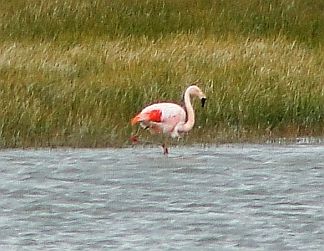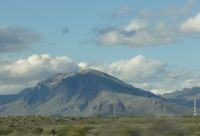
Publisher:
Bonnie King
CONTACT:
Newsroom@Salem-news.com
Advertising:
Adsales@Salem-news.com

~Truth~
~Justice~
~Peace~
TJP
Mar-11-2010 22:12

 TweetFollow @OregonNews
TweetFollow @OregonNews
The Chilean Flamingo, Flamenco Austral, Phoenicopterus Chilensis
Gail Parker Salem-News.comVisiting the gregarious flamingo.
 Photos courtesy: Gail Parker |
(PATAGONIA, Argentina) - The Patagonian steppe and desert are expansive and sparsely inhabited by humans. So, while driving from the Atlantic coast to the Andes Mountains the sudden appearance of a lake full of a hundred or more bright salmon-colored birds knocked my sox off.
 Chubut Mountains, Andes range |
With their great size, 43 inches, unmistakable silhouette, and brilliant coloration, one can’t help but recognize the flamingo and be astonished by its beauty.
The beak looks totally black from a distance, but in fact it is a rosy white with only the half extending to the apex being black. Their eyes are pale yellow. Their head and a third of the neck are white with a tinge of rose.
The rest of the neck and body are rose, and the wings as seen from the back are scarlet and black on the tips.
The legs and feet are a bluish grey in juveniles, greenish grey in adults, but in both the knees, toes and interdigital membranes are scarlet.
Photos by Gail Parker |
All of this remarkable color is influenced by their food. Flamingos with a higher protein percentage in their diet have darker coloring.
They feed upon phytoplankton and blue green algae mostly; this is collected from the bottom and filtered by their specially designed beaks.
Their mandibles and tongues are lined with lamellae. These structures filter the animal and plant plankton which comprise their diet.
The flamingo is very gregarious with its own kind, yet is very timid and sensitive to loud noises such as airplanes. When we approached, they immediately began distancing themselves from us.
We gamely followed and continued to try to focus and shoot photos, but they kept getting farther and farther away.
So we had to be satisfied with getting a little closer to their neighbors, the spoon-billed ducks who inhabit the same marshy lake. These ducks are difficult subjects to photograph also, but for a different reason... They are in a continuous bobbing motion, plunging their heads into the water and sending their tails pointed toward the sky. Swans accompanied our other friends that day, too.
 Gail Parker is a writer and photographer who lives in Argentina. She and her lifetime mate and husband Eddie Zawaski, who also writes for Salem-News.com, are former residents of Oregon, Gail has a great eye for memorable photos in this lush place called Patagonia. Her observations from this amazing wonderland of nature are a fun and welcome addition to our story flow.
Gail Parker is a writer and photographer who lives in Argentina. She and her lifetime mate and husband Eddie Zawaski, who also writes for Salem-News.com, are former residents of Oregon, Gail has a great eye for memorable photos in this lush place called Patagonia. Her observations from this amazing wonderland of nature are a fun and welcome addition to our story flow.
Watch for Gail's wonderful coverage of the birds of Patagonia in future stories and photojournals here on Salem-News.com.
Articles for March 10, 2010 | Articles for March 11, 2010 | Articles for March 12, 2010


Quick Links
DINING
Willamette UniversityGoudy Commons Cafe
Dine on the Queen
Willamette Queen Sternwheeler
MUST SEE SALEM
Oregon Capitol ToursCapitol History Gateway
Willamette River Ride
Willamette Queen Sternwheeler
Historic Home Tours:
Deepwood Museum
The Bush House
Gaiety Hollow Garden
AUCTIONS - APPRAISALS
Auction Masters & AppraisalsCONSTRUCTION SERVICES
Roofing and ContractingSheridan, Ore.
ONLINE SHOPPING
Special Occasion DressesAdvertise with Salem-News
Contact:AdSales@Salem-News.com


Terms of Service | Privacy Policy
All comments and messages are approved by people and self promotional links or unacceptable comments are denied.
Vic March 14, 2010 8:30 am (Pacific time)
Great story ! I have enjoyed these articles ! We have an incredible variety of birds here in San Blas also...I love the frigatas, or Frigate Birds ..
Jeff Kaye~ March 13, 2010 12:07 pm (Pacific time)
Nice story, Gail. Patagonia looks beautiful. I almost got a picture of a greenjay in my feeder this morning, but he took off right as I was aiming the camera. Maybe tomorrow...
gp March 12, 2010 11:05 am (Pacific time)
Height: 3.3 to 4.6 feet (1 to 1.4 meters) Wingspan: 3.3 to 5 feet (1 to 1.6 meters) Weight: 3.3 to 9 pounds (1.5 to 4.1 kilograms) Life span: 20 to 30 years; up to 50 years not unusual
[Return to Top]©2025 Salem-News.com. All opinions expressed in this article are those of the author and do not necessarily reflect those of Salem-News.com.